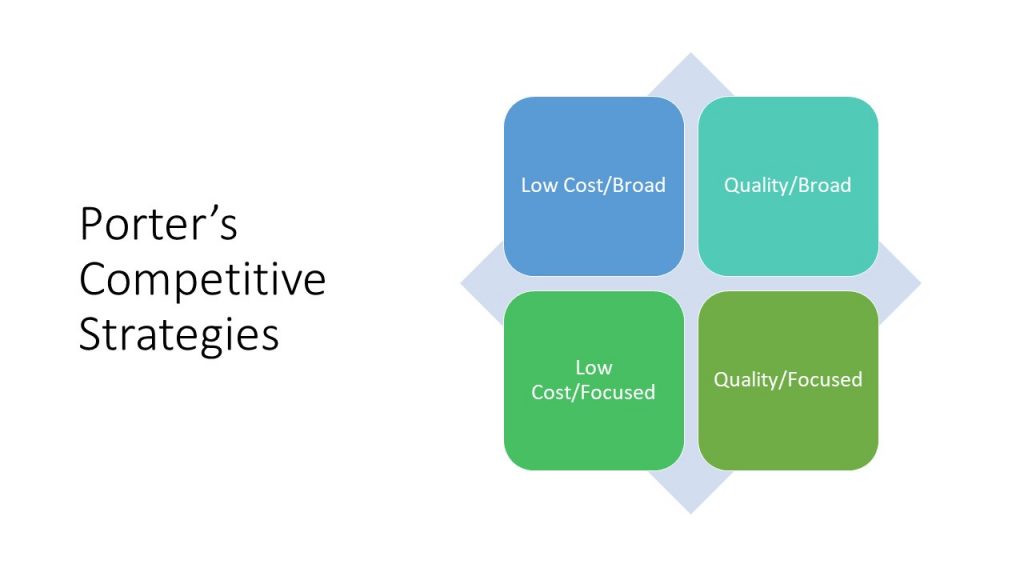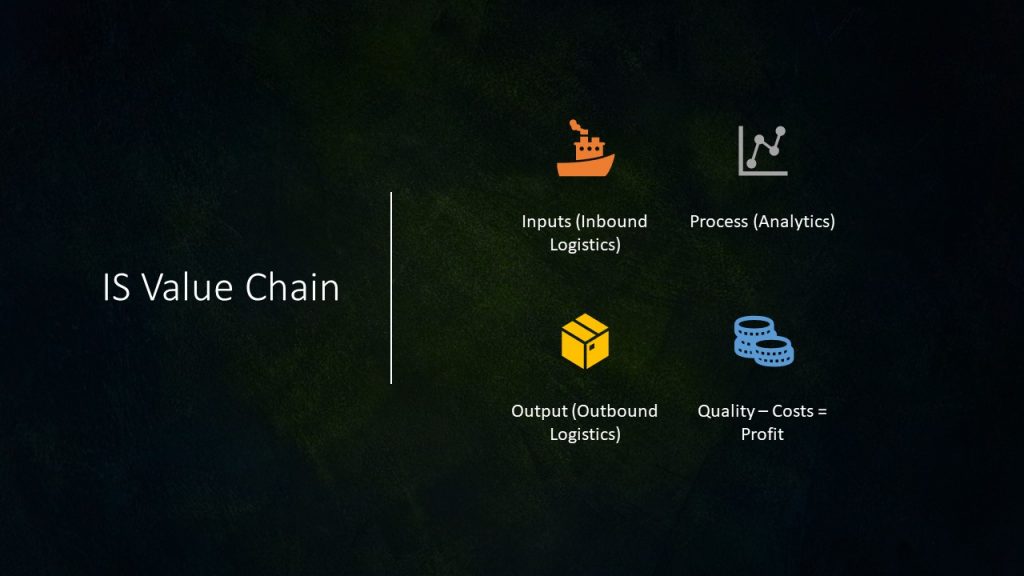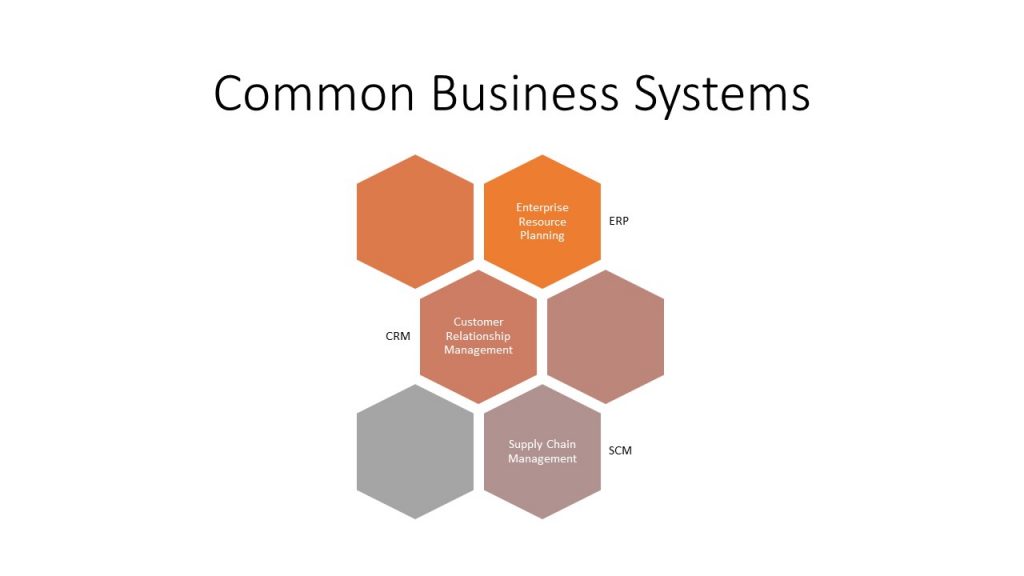6 Chapter 6 – Business Systems
Learning Objectives
Porter’s five forces, an IS perspective
Michael Porter developed a general model to help explain the major forces within industries. These common forces can be used to help guide strategy and lead to sustainable competitive advantages – profitable business processes and/or units that can continue to produce profits for long periods of time.
The five forces in Porter’s model include: threat of new entrants (entry), threats of substitutes (substitutions), bargaining power of customers (customers), bargaining power of suppliers (supply), and internal competition (rivals). Each of these five forces relate to one another, and when viewed from an information systems perspective, specific benefits and limitations appear depending on the overall strength of the force. In order to determine the overall ‘strength’ of a force, some subjectivity and overall scope needs to be incorporated into the process. Various methods can be used, particularly ranking, and the method a person will end up using can be dependent on many factors. In my experience, I tend to use a high-medium-low ranking system. While this causes many forces to be arguably medium, there are enough instances of high/low to make the ranking system somewhat effective in helping identify forces that can provide opportunities and/or threats.

Threat of new entrants
The force of ‘threat of new entrants’, or entry, can be described as the force that allows entry into the industry or market for new competitors or organizations. Ideally, if a company is already in the industry, the desire should be to have this threat or force be ‘low’. A low threat of entry means it is very difficult to enter the market or industry for new competitors. An example of this would be the automobile industry. A ‘high’ force would allow entrants to enter the market easily, such as food trucks, and should be a concern for existing organizations. One way information systems could be used to combat a high threat would be to provide complicated online services that become critical in the industry, creating another hurdle for new organizations to start (as they would have to develop and purchase the technology/systems).
Threat of substitutes
The force ‘threat of substitutes’ can be described as the ability in which the need of a customer can be met with a different product or service. In order to minimize this threat, or make the force be considered low is to offer something unique that is difficult to copy, replace, or substitute. Coca-Cola has a unique taste that is difficult to replicate, and even off-brand items that are very similar are typically shunned by cola drinkers that want Coca-Cola. An example of where the threat of substitutes would be considered high would be the common pen/pencil industry. Many people have containers of pens and pencils and likely mix and match writing utensils as they write. From an information systems perspective, technology or specific processes can provide the uniqueness in many cases, creating a different experience for customers.
Bargaining power of suppliers
The force ‘bargaining power of suppliers’ refers to the collective power of suppliers in regard to the ability to supply raw materials or products for manufacturing or service. While this force can be formed through various methods, it is common to consider the force to revolve around the price-setting ability of the suppliers. An example of a low bargaining power would be if many suppliers exist that supply very similar items, creating a price war among suppliers, thus reducing their bargaining power. An example of a high force in bargaining power would be a supplier that is the exclusive supplier of an item. From an information systems perspective, this force can be reduced through establishing relationships with suppliers and providing integrations between the systems in both organizations to ideally help reduce costs and prices.
Bargaining power of customers
The force ‘bargaining power of customers’ is very similar to the bargaining power of suppliers force; however, refers to the ability of customers to negotiate the price of an item or service. The bargaining power of customers would be considered high if customers have a strong influence of the final price of a product or service. This is typically in the form of negotiations, etc. The force would be considered low if the customer has no control over the final price. From an information systems perspective, the processes of how a final price is applied to the customer may be modified to eliminate or minimize the ability of negotiation. An example of this could be CarMax and their ‘instant trade’ offer and set prices on their website / mobile app. While the auto industry is rather famous for negotiations, by using these systems CarMax has reduced the ability for a customer to negotiate the final price.
Internal competition
The force ‘internal competition’ is a simple force to understand as it simply relates to the strength and number of competitors in the industry. Strong and numerous competitors would result in a strong force in this area. A lack of competitors or weak competitors, however, would result in a weaker internal competition force. From an information systems perspective, internal competition can be reduced by creating alliances through collaboration and also acquiring and integrating your competitors into your business structure. While these are not direct information systems involvements, indirectly they require a tremendous amount of risk analysis and modeling, which is part of information systems!
Competitive strategies
Once the industry has been outlined and ranked, this information can be used to complete a competitive strategy analysis. Porter essentially divides the entire market into four segments based on market focus and cost/quality. The four segments created are focus/cost, focus/quality, broad/cost, and broad/quality. Understand in this description quality is being used loosely, as you may be able to have a lower quality product that is sold at a premium price.
Broad/Focus
Broad/Focus, as a competitive strategy variable, refers to the overall market and how much of that market is being targeted by an organization. If the organization is dividing the market into segments (such as young/old), then that organization is using a focus strategy and should be mapped in the grid on the focus side. A broad organization, while likely still segmenting, is however attempting to reach the entirety of the market.
Cost/Quality
Cost/Quality, as a competitive strategy variable, refers to the extent in which an organization prioritizes having low-cost final products or high-quality final products (or services). An organization that chooses low cost will typically have less desirable or minimal additional services for customers in order to provide the lowest final price to the customer. An organization that chooses quality will attempt to differentiate their products or services from those of competitors and low-cost providers.

Choosing a competitive strategy
Regardless of whether an organization is considering entering the industry or already exists within the industry, one can plot out competitors on a 2×2 grid in order to better visualize a vacant quadrant or super concentrated quadrant. If a quadrant is vacant, an investigation into why that quadrant is vacant may occur. If all quadrants are covered, a discussion on the strengths of the competitors within that quadrant may occur. It is rather common for at least one competitor to be the ‘leader’ of a quadrant, such as Walmart is the leader of the low cost / broad market quadrant.
The value chain
Regardless of competitive strategies and overall industry analysis of the five forces, the value chain is where an organization can begin identifying specific areas to improve. While the value chain encompasses all areas of an organization, in this text, the focus is just on information systems. By focusing just on information systems, the value chain is simplified to the three areas of Input, Processing, and Output (think Chapter 1!).
Before examining each IPO component, however, one must understand that the goal of the value chain is to increase value. In this context, ‘value’ is the perceived quality (or price) of a product or service. The equation for the value chain is Revenue – Cost = Margin. Or another way to express the equation is Quality – Cost = Profit. This provides two ways to increase profit – increase the perceived quality of the product or service and/or reduce the costs to make said product or service.
Inputs, in the value chain context, refer to items coming into the organization. The possibilities of enhancing quality and reducing costs are plentiful and likely dependent on the industry. However, if information is involved, increasing the quality of that information may not only help increase the quality but also reduce costs. For example, if parts are arriving in small quantity shipments, an analysis could be done to see if larger quantities could reduce loading/unloading, etc. This may make the product be assembled and ship faster, increasing quality, while taking less time, reducing costs.
Processing, in the value chain context, can refer to any process involved in transforming raw materials into finished goods. Common methods for increasing quality may be better testing systems or the introduction of robotics in order to provide more precise movements. Costs may be reduced as well through automation, or software may be created that replaces bulky, expensive outsourced software.
Outputs, in the value chain context, can refer to the processes from finished goods to delivery. This may involve new logistics to increase shipping speed, and marketing analysis to find new market segments or trends. Costs may be reduced by reducing expensive packaging, selling in bulk, and/or improving the communication within the organization in terms of selling points to raw material reordering.

Enterprise resource planning
In the 1990s, the need to bring the organization’s information back under centralized control became more apparent. The enterprise resource planning (ERP) system (sometimes just called enterprise software) was developed to bring together an entire organization in one software application. Simply put, an ERP system is a software application utilizing a central database that is implemented throughout the entire organization. Let’s take a closer look at this definition:
• “A software application”: An ERP is a software application that is used by many of an organization’s employees.
• “utilizing a central database”: All users of the ERP edit and save their information from the data source. What this means practically is that there is only one customer database, there is only one calculation for revenue, etc.
• “that is implemented throughout the entire organization”
An ERP can be used to manage an entire organization’s operations. If they so wish, companies can purchase modules for an ERP that represent different functions within the organization, such as finance, manufacturing, and sales. Some companies choose to purchase many modules, others choose a subset of the modules.
An ERP system not only centralizes an organization’s data, but the processes it enforces are the processes the organization adopts. When an ERP vendor designs a module, it has to implement the rules for the associated business processes. A selling point of an ERP system is that it has best practices built right into it. In other words, when an organization implements an ERP, it also gets improved best practices as part of the deal!
For many organizations, the implementation of an ERP system is an excellent opportunity to improve their business practices and upgrade their software at the same time. But for others, an ERP brings them a challenge: Is the process embedded in the ERP really better than the process they are currently utilizing?
And if they implement this ERP, and it happens to be the same one that all of their competitors have, will they simply become more like them, making it much more difficult to differentiate themselves?
This has been one of the criticisms of ERP systems: that they commoditize business processes, driving all businesses to use the same processes and thereby lose their uniqueness. The good news is that ERP systems also have the capability to be configured with custom processes. For organizations that want to continue using their own processes or even design new ones, ERP systems offer ways to support this through the use of customizations.
But there is a drawback to customizing an ERP system: organizations have to
maintain the changes themselves. Whenever an update to the ERP system comes out, any organization that has created a custom process will be required to add that change to their ERP. This will require someone to maintain a listing of these changes and will also require retesting the system every time an upgrade is made. Organizations will have to wrestle with this decision: When should they go ahead and accept the best-practice processes built into the ERP system and when should they spend the resources to develop their own processes? It makes the most sense to only customize those processes that are critical to the competitive advantage of the company.
Some of the best-known ERP vendors are SAP, Microsoft, and Oracle.
Customer relationship management
A customer relationship management (CRM) system is a software application designed to manage an organization’s customers. In today’s environment, it is important to develop relationships with your customers, and the use of a well-designed CRM can allow a business to personalize its relationship with each of its customers. Some ERP software systems include CRM modules. An example of a well-known CRM package is Salesforce.
Supply chain management
Many organizations must deal with the complex task of managing their supply chains. At its simplest, a supply chain is the linkage between an organization’s suppliers, its manufacturing facilities, and the distributors of its products. Each link in the chain has a multiplying effect on the complexity of the process: if there are two suppliers, one manufacturing facility, and two distributors, for example, then there are 2 x 1 x 2 = 4 links to handle. However, if you add two more suppliers, another manufacturing facility, and two more distributors, then you have 4 x 2 x 4 = 32 links to manage.

Chapter 6 Assignment
OVERVIEW
This assignment will help you apply porter’s forces to an organization to find competitive opportunities using technology.
ASSIGNMENT
In this assignment you will choose an organization, and then walk through each force and ultimately choose a technology strategy to create an advantage.
STEPS
- Choose an industry, and then choose an organization within that industry. Describe both briefly.
- Using Porter’s Five Forces, for each force describe a ‘problem’ and an ‘opportunity’ within each force for the organization you selected in the above step.
For Example: If I chose fast food and McDonald’s, a problem for McDonalds in the customer force is that customers are increasingly becoming health focused. An opportunity for McDonald’s would be to explore ‘power shakes’ that include workout supplements. - Next, examine the four basic competitive strategies. For each strategy, identify your selected organization’s main competitor that would fit in that strategy (describe why you feel it fits). Which strategy (area) provides the most opportunity for your organization and which area does your organization belong to?
- Finally, make a statement on what your selected organization’s strategy should be.
GRADING
A satisfactory submission will include an industry description, a problem/opportunity for each force, a competitive strategy and competitor discussion and a statement of strategy. These items should demonstrate some reflection and thought.
A beyond satisfactory submission may provide an organized layout of the journey from the five forces to organizational strategy. It would likely include detailed and logical explanations of possible pitfalls and opportunities for the organization in question at each step.

